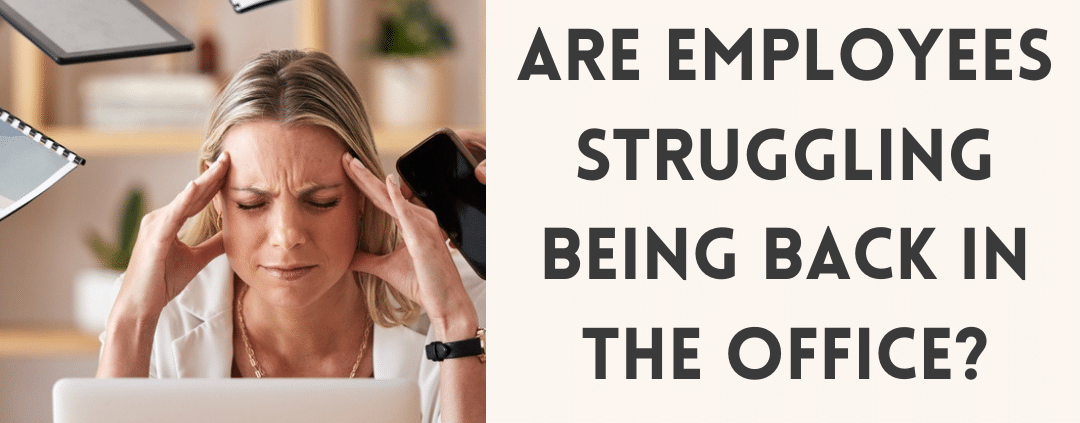Are Employees Struggling, Being Back in the Office
 Some employees are struggling with being back in the office. Quite a few companies require employees to return to the office full-time or increase the number of days. I have definitely noticed a trend so far in 2023. I know many people who are being urged to amp up their office presence. Typically, the request is for an increase of 3-4 days a week in the office.
Some employees are struggling with being back in the office. Quite a few companies require employees to return to the office full-time or increase the number of days. I have definitely noticed a trend so far in 2023. I know many people who are being urged to amp up their office presence. Typically, the request is for an increase of 3-4 days a week in the office.
Is the remote working trend slowly dying off? Is hybrid still an option for many? How do the employees feel about this? These are the questions that struck me as I researched whether the trend was more widespread and how employees really feel about it.
According to Business Insider, larger companies are mandating that employees need to be back in the office full-time. Many employees were so upset with the reversal of flexible working policies that they filed a petition against the changes. Others have been reported in many articles citing headlines like “Return to Work Wars”.
The Companies Mandating Employees Return to the Office (businessinsider.com)
Remote and hybrid
Remote and hybrid ways of working have a lot of benefits, such as flexible hours and the ability to work from anywhere in the world. But it can also be difficult to get work done when you’re isolated from others.
According to the CIPD “More action is needed to increase the uptake of a range of flexible working arrangements to create more inclusive, diverse and productive workplaces that suit both the needs of organisations and individuals.”
Clearly, the best practice is seen to be giving employees the option of flexible working. The CIPD is campaigning for it. Gallup poll data shows that employees are leaving if they are not getting the flexibility they want. So what is the issue with employers continuing to embrace it?
The CIPD Good Work Index points to a number of barriers to be overcome:
- Line manager attitudes
- Lack of senior-level support
- Concerns about meeting operational and customer requirements
- The nature of the work people do.
A two-tier system?
Many people moved out of cities during the pandemic, myself included. Now there is a split between those that are still local and able to travel into the office regularly, and those that are mostly remote with only the occasional trip in. Roughly once a month or less is what I see.
Is this causing a two-tier system between the employees with remote workers being more isolated and cut off from the rest of the workforce? When everyone was working from home, most employees made an effort to ensure more effective and frequent communication. Are the people back in the office forgetting to do this, now the majority of people are available for face-to-face meetings on a regular basis? The people I have spoken to report feeling more cut off from their office-based peers. They also report that they are finding it more difficult to find out information as people forget to keep them in the loop.
This situation supports neither the employee nor the organisation, so it is failing on both counts.
Why are employees struggling?
According to the latest Gallup research, six in ten employees with remote-capable jobs want a hybrid work arrangement. One-third prefer fully remote work, and less than 10% prefer to work on-site.
While some employees may be happy to return, others prefer the ability to get work done without interruptions and no commutes. For these employees, the thought of returning to the office stirs up anxiety and even dread.
The reasons for return-to-office dread are very personal and vary so much between individuals. Some are worried about losing the free time they’ve gained without a commute, the ability to pick up the kids, or throwing some laundry in the washing machine between meetings. Many found that office politics were less when home-based while others dread going back to that soul-destroying commute.
Research worldwide has many psychologists convinced that the mental and physical stress of a long commute is rarely worth it. If you have a long commute, it’s taking the place of something in your life that’s healthy. It also reduces time with your family and friends.
However, some people are actually enjoying being back, that they are back into the routine. A recent study by the BBC found that, after years of resisting, some workers are back at their desks. The secret? They don’t hate it. They are enjoying the camaraderie and the fact that you can go seek people out and sort problems quickly.
You can read more about their perspective here: The workers quietly backtracking on return-to-office – BBC Worklife
Are employees more productive in the office?
Gallup data show that spending two to three days in the office during a typical week tends to lead to the highest levels of employee engagement, and tends to reduce burnout and intentions to leave the organization. However, employees’ unique job responsibilities, as well as their team’s collaboration and customer service requirements, should be considered when determining hybrid work schedules. For instance, highly collaborative jobs requiring frequent real-time interactions often benefit from more time in the office than jobs that are done mostly independently.
A study by Forbes found that employees who work remotely are three times as likely to struggle with productivity as those who work in an office setting. There are a few reasons for this:
- Employees struggle because they have less face-to-face interaction with their boss, which can lead to decreased motivation and increased distraction.
- Employees who work remotely often have to rely on technology to stay connected, which can lead to less effective communication.
- Remote workers are less likely to get feedback on their work, which can lead to frustration and a decreased level of productivity.
In order for employees to be productive in the office, they need to have a balanced routine that includes face-to-face interaction, good communication tools, and regular feedback.
 What about Gen Z?
What about Gen Z?
I am particularly interested to read an article about Gen Z workers and how they are starting on the back foot, in terms of understanding the work environment. Particularly the experience they gain from osmotic communication and being set up for success at work, by being co-located and learning from those around them. Some experts feel that entry-level workers are missing out on picking up vital cues that guide behaviour, collaboration, and networking. It is making fundamental work much harder to achieve. What is the etiquette and the norms? Who should you call? How should they be contacted? Are some people out of bounds? Plus a whole host of other questions they need to be answered.
The experience is leading to a whole different area of anxiety for these employees. Of course, it’s not the case that every new Gen Z worker is struggling. But for many of these inexperienced employees, virtual work settings can exacerbate new job stress.
What does the future look like?
I can see the pros and cons of both the argument for flexibility from the employee, and at the same time, the data backing up the need for regular time in the office.
Being in the office supports both the integration and productivity of the team. The sharing of osmotic communications. The passing on of tacit knowledge. The ability to be able to hash things out and spark ideas of each other.
At the same time the need to support employee mental health and wellbeing. Enabling flexibility and being a more inclusive organisation that supports everyone’s needs is critical.
I worked for years in large global, diverse organisations. That was back in the day when companies could afford to pay for employees to get together at least annually, from all around the world. There was definitely an understanding that the team-building element that this enabled was critical. However, I still managed to build lasting relationships with remote colleagues that I never met in person. It just took a lot more work.
My conclusion is that all is possible. With a lot of work. For me though, hybrid working gives the best of everything. It will enable the needs of the organisation and support the employees at the same time. At the end of the day what most people want is choice.
In a climate where finding talent is exceedingly difficult, as an employer you better start listening!



